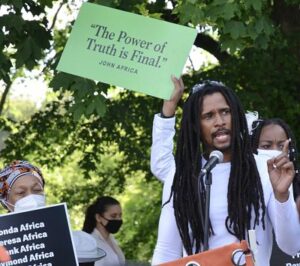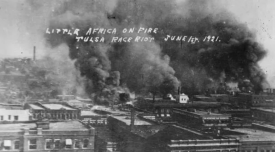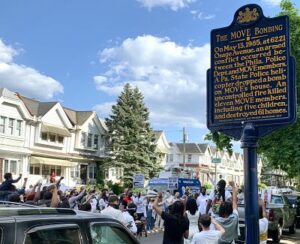
Buried inside an embarrassing scandal now broiling Philadelphia, Pa are legacies from America’s despicable era of lynching.
The spark for the scandal in Philadelphia is revelations about morbid mistreatment of human remains of Black victims from the horrific 1985 police bombing and burning in Philadelphia of the back-to-nature group MOVE.
During the lynching era, many who participated in murderous mob spectacles, frequently mutilated the dead bodies of lynch victims, severing body parts to display in jars kept inside their homes like trophies from an animal hunt.
This current scandal over remains of MOVE members killed in 1985 erupted in April 2021 after a whistleblower revealed that two anthropologists associated with the University of Pennsylvania kept charred bones of two children murdered in that MOVE bombing for over three decades…seemingly treating those remains like trophies.
That heinous 1985 bombing/burning was a ‘First’ for police anywhere in America.
During the May 31, 1921 racist rampage that destroyed the ‘Black Wall Street’ section of Tulsa, Oklahoma bigots did drops burning objects from airplanes on that Black community. But those bigots were not official policemen (like in 1985 Philadelphia) despite those bigots acting to aid police who were aiding racist rioters during that massacre.
That assault in Tulsa began after Blacks blocked an attempted lynching.
Gruesome murders were hallmarks of the ugly lynching era. Lynching’s often occurred in public attended by hundreds who reveled in picnic-like atmospheres.
During that infamous May 13, 1985 incident Philadelphia authorities deliberately allowed a fire ignited by that police bomb to rage into an inferno that incinerated eleven MOVE members. The dead included five children who ranged in age from eight to fourteen years old.

Philadelphia television stations broadcast much of the 1985 incident live as it occurred.
During the lynch era – roughly from the early 1880s to the mid-1960s — lynchers often burned their victims alive as they dangled from nooses around their necks…as crowds cheered!
Months after that fiery 1985 incident, investigators with the City of Philadelphia’s MOVE Commission determined gunfire from police snipers prevented MOVE members from fleeing their burning rowhome where temperatures inside exceeded 2,000-degrees.
Only one adult MOVE member and one child escaped that blaze, both burned badly.
In 1985, Philadelphia officials retained those UPenn anthropologists to help identify which incinerated MOVE member the bones belonged to. The insensitive failure of those anthropologists to return the remains to either City of Philadelphia pathologists or to the families of the victims incinerated in the MOVE bombing in succeeding decades aggravated their bone-snatching.
Those anthropologists shuffled MOVE bones between UPenn and Princeton University. One of those anthropologists even utilized the children’s bones in an online course taught through Princeton. A coalition of Blacks in anthropology, archeology and bioanthropology recently blasted the barbarity of all entities that “effectively monetized the remains of Black children murdered in a state terrorist attack.”
Days after that whistleblower exposed the abhorrent acts of those anthropologists, Philadelphia’s Mayor revealed another outrageous act.
Philadelphia’s Health Commissioner, in 2017, ordered cremation of a different set of MOVE bones from that 1985 inferno. The Health Commissioner issued that order without any effort to return those remains to MOVE members, some of whom lived about one mile from Philadelphia’s morgue that housed those remains.
Additional outrage flared just hours after the Mayor fired his Health Commissioner for that 2017 order. News broke that morgue employees did not cremate those bones as ordered. But the bones remained in the custody of the city’s coroner.
The mistreatment of MOVE bones is now the subject of separate investigations by the City of Philadelphia and UPenn.
Perversely, this new scandal reignites stern criticism of the City of Philadelphia Medical Examiner’s Office contained in the report from the city’s official investigation of that 1985 incident. The report from the city’s MOVE Commission seared that M.E. Office for unprofessional conduct which “violated generally accepted practices for pathologists.”
Part of that report’s criticism concerned botched recovery of body parts from ruins of the house where MOVE members barricaded themselves.
The May 1985 blaze from that police bombing also destroyed 61 homes in a Black neighborhood, leaving 250 people homeless – their life possessions callously destroyed by cold-hearted decisions of governmental authorities.
The MOVE Commission found racism operative in that 1985 conflagration. The MOVE Commission concluded approval for dropping a bomb on that house containing children and allowing that fire to burn out of control would not have occurred if the confrontation occurred “in a comparable white neighborhood.”
Raw racial prejudice drove lynching.
Just like the lynching era where arrests of murderous lynch mob members was rare and convictions rarer, Philadelphia and federal prosecutors refused to arrest any police or city government officials for that deadly, reckless 1985 catastrophe.
After the bloody May 31, 1921 racist rampage in Tulsa, Oklahoma authorities refused to prosecute any of the white rioters who decimated the prosperous “Black Wall Street” community. That rampage 100-years ago erupted after Blacks in Tulsa blocked the lynching of a Black man falsely accused of brushing into a white female elevator operator.

Racist rioters in Tulsa burned down hundreds of homes and businesses, murdering hundreds, leaving over 10,000 homeless in the Greenwood community, the community demeaned by whites as ‘Little Africa.’
Yet local and federal prosecutors secured no convictions of the few rioters arrested for crimes like arson and looting. Further, prosecutors did not hold Tulsa police accountable for failing to arrest murderous rioters or National Guard members who assaulted Black victims but not white rioters.
A Tulsa grand jury in 1921 blamed Blacks for the massacre. That grand jury report declared that Blacks who blocked a planned lynching were “the direct cause of the entire affair.” That report also lambasted “agitation among” Blacks for “social equality” as another cause for the racist rampage.
Racist denial of justice to victims of racism is a persistent thread in the fabric of both Philadelphia and the United States.
While the 1986 MOVE Commission report characterized the deaths of the five MOVE children “unjustified homicides” prosecutors essentially declared that those five dead MOVE children and six MOVE adults were responsible for their own deaths.
The MOVE Commission, unlike prosecutors, had no legal authority to arrest and prosecute.
Prosecutors – local and federal – perverted law with illogical assertions to absolve misconduct by police and city authorities during that 1985 incident.
Philly prosecutors claimed police gunfire did not block MOVE members from fleeing the fire. Prosecutors asserted some MOVE members returned to the blazing building either because they wrongly believed that police were shooting at them or because they intended to commit suicide.
That illogical assertion of mass suicide from prosecutors contradicted MOVE Commission findings that documented police gunfire blocked MOVE members from fleeing the fire. The Commission found police bullets inside the bones of MOVE members – bullets that won’t be inside those bones if not for police gunfire.
Federal prosecutors claimed that incendiary 1985 assault did not violate the civil rights of the dead MOVE children. While federal prosecutors praised the FBI for its assistance in their investigation clearing law enforcers of wrongdoing, those prosecutors made no mention of Philadelphia police getting the powerful military C-4 high explosive they used in their bomb from the FBI.
The MOVE children incinerated in 1985 survived a brutal assault by Philadelphia police in August 1978. That assault, where a policeman died, led to decades long imprisonment of parents of four of the five children incinerated in 1985.
During that 1978 assault those children (and their parents) survived withering police gunfire, suffocating vapors from dozens of tear gas and smoke grenades unleashed by police plus possible drowning from over 200,000-gallons of water police dumped into the basement where MOVE members huddled.
In another instance of insensitivity, the day after that fiery 1985 incident, prison guards taunted the imprisoned MOVE parents, mocking the deaths of their children. The parents of two of those dead children served 40-years in prison before their paroles a few years ago. Terrorizing and otherwise dehumanizing Blacks was an essential element in the dynamics of lynching.
Efforts by MOVE to gain release of nine members imprisoned for that fatal 1978 clash produced conflicts with Philadelphia authorities that culminated in the deadly May 1985 bombing-&-burning.
Surprisingly, those MOVE efforts to gain release of imprisoned members included harassing their neighbors – verbally & physically. MOVE’s assaults on its Black neighbors undermined MOVE’s self-identification as a Black revolutionary organization.

A driving force behind repeated confrontations between MOVE and Philadelphia authorities – beginning in the mid-1970s – was authorities consistently penalizing MOVE for minor infractions but failing to punish law enforcement personnel for brutality. That brutality included beatings where law enforcers kicked female MOVE members in their genital areas causing miscarriages.
Authorities excusing crimes of white racists is not a phenomena exclusive to the 20th Century.
Almost 147-years before the 1985 police bombing of MOVE, a white mob in Philadelphia, burned down the then newly built headquarters of the Pennsylvania Anti-Slavery Society. Authorities in Philadelphia, however, made no arrests for that May 17, 1838 arson.
Philadelphia officials in 1838 duplicitously declared strangers composed that rampaging arson mob, thus none were recognizable for apprehension. However, contemporaneous accounts stated “gentlemen of property and standing” composed that mob. If persons were identifiable enough to note their ‘standing,’ those persons were identifiable enough for authorities to hold them accountable for their arson…that is: if authorities really cared about holding the culprits responsible.
The failure to hold anyone accountable for deaths of MOVE members in 1985 remains a burning injustice…just as are failures on accountability following the 1921 Tulsa riot.
